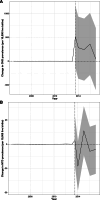Direct potable reuse and birth defects prevalence in Texas: An augmented synthetic control method analysis of data from a population-based birth defects registry
- PMID: 38617421
- PMCID: PMC11008670
- DOI: 10.1097/EE9.0000000000000300
Direct potable reuse and birth defects prevalence in Texas: An augmented synthetic control method analysis of data from a population-based birth defects registry
Abstract
Background: Direct potable reuse (DPR) involves adding purified wastewater that has not passed through an environmental buffer into a water distribution system. DPR may help address water shortages and is approved or is under consideration as a source of drinking water for several water-stressed population centers in the United States, however, there are no studies of health outcomes in populations who receive DPR drinking water. Our objective was to determine whether the introduction of DPR for certain public water systems in Texas was associated with changes in birth defect prevalence.
Methods: We obtained data on maternal characteristics for all live births and birth defects cases regardless of pregnancy outcome in Texas from 2003 to 2017 from the Texas Birth Defects Registry and birth and fetal death records. The ridge augmented synthetic control method was used to model changes in birth defect prevalence (per 10,000 live births) following the adoption of DPR by four Texas counties in mid-2013, with county-level data on maternal age, percent women without a high school diploma, percent who identified as Hispanic/Latina or non-Hispanic/Latina Black, and rural-urban continuum code as covariates.
Results: There were nonstatistically significant increases in prevalence of all birth defects collectively (average treatment effect in the treated = 53.6) and congenital heart disease (average treatment effect in the treated = 287.3) since June 2013. The estimated prevalence of neural tube defects was unchanged.
Conclusions: We estimated nonstatistically significant increases in birth defect prevalence following the implementation of DPR in four West Texas counties. Further research is warranted to inform water policy decisions.
Keywords: Augmented synthetic control method; Birth defects; Congenital anomalies; Congenital heart disease; Direct potable reuse; Drinking water; Neural tube defects; Pregnancy; Prevalence.
Copyright © 2024 The Authors. Published by Wolters Kluwer Health, Inc. on behalf of The Environmental Epidemiology. All rights reserved.
Conflict of interest statement
M.O.G. previously owned shares in a water sector mutual fund (FLOWX) that he has divested. The other authors declare that they have no conflicts of interest with regard to the content of this report.
Figures


References
-
- Arnold RG, Saez AE, Snyder S, et al. . Direct potable reuse of reclaimed wastewater: it is time for a rational discussion. Rev Environ Health. 2012;27:197–206. - PubMed
-
- Scruggs CE, Pratesi CB, Fleck JR. Direct potable water reuse in five arid inland communities: an analysis of factors influencing public acceptance. J Environ Planning Manage. 2020;63:1470–1500.
-
- Colorado Department of Public Health and Environment. Regulation No. 11 - Colorado Primary Drinking Water Regulations. Colorado Secretary of State. Available at: https://www.sos.state.co.us/CCR/GenerateRulePdf.do?ruleVersionId=8999&fi.... Accessed 15 August 2023.
-
- Texas Commission on Environmental Quality. Direct Potable Reuse for Public Water Systems. Available at: https://www.tceq.texas.gov/downloads/drinking-water/rg-634.pdf. Accessed 15 August 2023.
